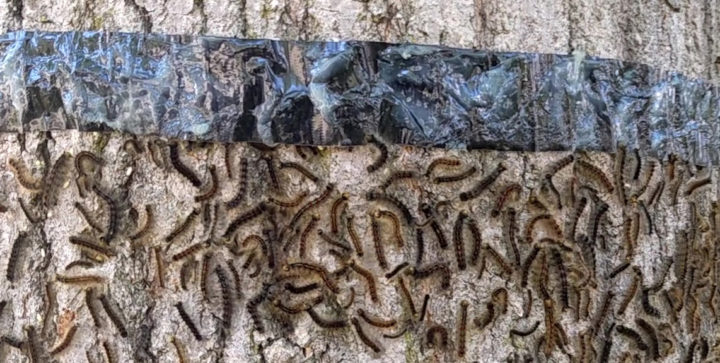
Here in Northwest Vermont, we’ve had outbreaks of spongy moths for the past two years. These pests eat vast quantities of leaves when in their caterpillar phase and especially love munching on oak trees. If their population is large enough on a given tree, the leaves can be entirely consumed by the end of June, leaving the tree bare if/until it can grow a new set of leaves later in the summer.
My property is shaded by 11 mature oak trees, so I’ve been battling these suckers for the past month and a half. Last year it was clear that there was a problem, but I didn’t take any mitigation methods other than killing caterpillars I could reach on the sides of trees and my house. Looking back on it, I realize that was not at all effective, as there were many, many moths that emerged to breed and produce fertilized eggs that hatched this spring.
The quantity of caterpillars this year has been shocking and not a little disgusting. Not only do they crawl all over the place (I’ve kept a broom by my front door to sweep them off the overhang when I go outside), but they also defecate constantly. You can hear the pattering of their poops hitting leaves on the way down (it sounds like a light rain), and the poop swells in size and becomes slimy when it gets wet. They also have a phase where they hang from threads hoping to catch a breeze to a new tree (it’s called “ballooning”). The danger of having them drop on you is real, and you really don’t want that, as their bodies can cause a nasty rash if they touch your skin.
I needed to Do Something, so I turned to the internet for advice. Unfortunately, the guidance out there is not very helpful or accurate. Don’t bother with burlap (they mostly crawl over it) or applying duct tape sticky side out (it dries up within 2-3 days and stops being effective). Insecticide sprays can be helpful for young trees or smaller species like apples, but are useless for trees of any size like my oaks. But with some research and experimentation, I did find some techniques that really make a difference.
Technique 1: insecticide injections. This is the most targeted and effective method, as the tree wicks the poison up into its leaves where the caterpillars eat it and die. There is very little waste, and other beneficial insects are not harmed. There are both short-acting (a few weeks) and long-acting (a couple of years) options available at different price points. The downsides are: 1) it can be very expensive; 2) it requires an expert (like an arborist) to apply it, as it might not work and/or the trees can be damaged if you do it wrong. This technique was not practical for me, because my trees are large (~50 feet tall) and numerous, and it would have cost thousands of dollars to inject them with the right dosages to achieve the goal.
Technique 2: duct tape bands with petroleum jelly. It’s more work and less effective than injections, but it really makes a difference as long as you do it early enough, ideally before the “ballooning” stage of the caterpillars’ development. What you want to do is encircle the trunk of your tree with a band of duct tape, sticky side in, then apply a layer of petroleum jelly (e.g. Vaseline) over the duct tape using a putty knife. Check the tape daily to make sure it’s still stuck to the tree, and make repairs as needed. The reason this works is that a significant number of caterpillars either descend from the tree on a thread or fall to the ground randomly then try to crawl back up into the tree. The band around the tree acts as a roadblock, as they do not like the petroleum jelly at all and will not crawl on it. (And, importantly, it does not dry out, unlike duct tape sticky side out.) They gather in large numbers below the tape, where they can be easily dispensed with using whatever method you prefer. What I ended up doing was buying a wet/dry vacuum, putting some soapy water inside, then sucking the caterpillars off the trees into the bucket o’ doom. Once they are dead (it does not take long), you can pour the water and their remains out onto your lawn for some extra fertilizer. Repeat regularly.

It’s July now, and the caterpillar phase has pretty much ended here. My trees were significantly damaged, but none were totally defoliated, in contrast to some of the neighbors’ trees. My actions clearly made a difference. There was also more rain this year than last, which caused a rebound of the parasitic fungus that kills the caterpillars. It was a huge relief when this took hold about a month into the season. I am hopeful that next year things will be back to something more like normal. But if not, at least I have found some battle tactics that work.